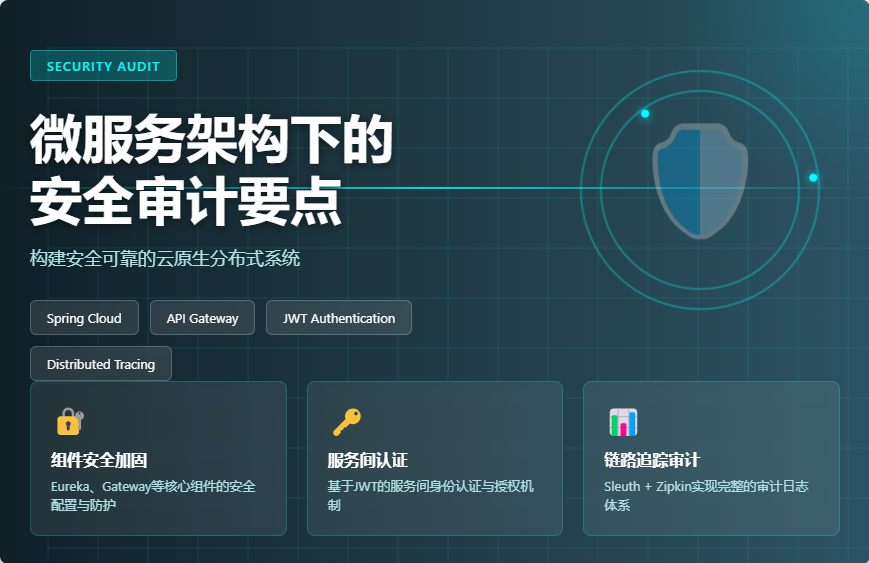微服务架构下的安全审计要点
在云原生时代,微服务架构已经成为企业级应用的主流选择。然而,服务的分布式特性也带来了新的安全挑战。今天我们就来深入探讨微服务架构下的安全审计关键要点,帮助开发团队构建更加安全可靠的系统。

一、微服务安全面临的挑战
传统单体应用的安全边界清晰,而微服务架构将应用拆分为多个独立服务,服务间通过网络通信,这使得攻击面大幅增加。每个服务都可能成为潜在的攻击入口,服务间的调用链路也需要严格的安全防护。
在这样的背景下,安全审计不再是可有可无的附加功能,而是系统稳定运行的重要保障。
二、Spring Cloud组件安全防护
Spring Cloud作为微服务开发的主流框架,其核心组件的安全配置至关重要。
Eureka注册中心安全
注册中心是微服务的"通讯录",一旦被攻破,攻击者可以获取所有服务的地址信息。我们需要为Eureka启用身份认证:
@Configuration
@EnableWebSecurity
public class EurekaSecurityConfig extends WebSecurityConfigurerAdapter {
@Override
protected void configure(HttpSecurity http) throws Exception {
http.csrf()
.ignoringAntMatchers("/eureka/**")
.and()
.authorizeRequests()
.antMatchers("/actuator/**").hasRole("ADMIN")
.anyRequest().authenticated()
.and()
.httpBasic();
}
@Bean
public UserDetailsService userDetailsService() {
UserDetails admin = User.builder()
.username("admin")
.password(passwordEncoder().encode("secure_password"))
.roles("ADMIN")
.build();
return new InMemoryUserDetailsManager(admin);
}
@Bean
public PasswordEncoder passwordEncoder() {
return new BCryptPasswordEncoder();
}
}
服务发现安全审计
实现服务注册与发现的审计日志记录:
@Component
@Slf4j
public class ServiceRegistryAuditor implements ApplicationListener<InstanceRegisteredEvent> {
@Autowired
private AuditLogService auditLogService;
@Override
public void onApplicationEvent(InstanceRegisteredEvent event) {
InstanceInfo instanceInfo = event.getInstanceInfo();
AuditLog log = AuditLog.builder()
.eventType("SERVICE_REGISTER")
.serviceName(instanceInfo.getAppName())
.instanceId(instanceInfo.getInstanceId())
.ipAddress(instanceInfo.getIPAddr())
.timestamp(LocalDateTime.now())
.status("SUCCESS")
.build();
auditLogService.record(log);
log.info("服务注册审计: {} - {} - {}",
instanceInfo.getAppName(),
instanceInfo.getInstanceId(),
instanceInfo.getIPAddr());
}
}
三、API网关安全审计
API网关是微服务对外的统一入口,也是安全防护的第一道防线。
请求审计拦截器
在Spring Cloud Gateway中实现全局请求审计:
@Component
@Slf4j
public class SecurityAuditGlobalFilter implements GlobalFilter, Ordered {
@Autowired
private AuditLogRepository auditLogRepository;
@Autowired
private RedisTemplate<String, Object> redisTemplate;
@Override
public Mono<Void> filter(ServerWebExchange exchange, GatewayFilterChain chain) {
ServerHttpRequest request = exchange.getRequest();
String requestId = UUID.randomUUID().toString();
// 记录请求开始时间
long startTime = System.currentTimeMillis();
// 构建审计日志对象
GatewayAuditLog auditLog = GatewayAuditLog.builder()
.requestId(requestId)
.method(request.getMethod().name())
.uri(request.getURI().toString())
.clientIp(getClientIp(request))
.userAgent(request.getHeaders().getFirst("User-Agent"))
.requestTime(LocalDateTime.now())
.build();
// 检测可疑请求
if (isSuspiciousRequest(request)) {
auditLog.setRiskLevel("HIGH");
auditLog.setRiskReason("疑似SQL注入或XSS攻击");
auditLogRepository.save(auditLog);
return exchange.getResponse()
.writeWith(Mono.just(
exchange.getResponse()
.bufferFactory()
.wrap("请求被拒绝".getBytes())
));
}
return chain.filter(exchange).then(Mono.fromRunnable(() -> {
long duration = System.currentTimeMillis() - startTime;
auditLog.setDuration(duration);
auditLog.setStatusCode(exchange.getResponse().getStatusCode().value());
// 异步保存审计日志
auditLogRepository.save(auditLog);
// 记录慢请求
if (duration > 3000) {
log.warn("慢请求告警: {} - {} - {}ms",
request.getURI(), requestId, duration);
}
}));
}
private String getClientIp(ServerHttpRequest request) {
String ip = request.getHeaders().getFirst("X-Forwarded-For");
if (ip == null || ip.isEmpty()) {
ip = request.getRemoteAddress().getAddress().getHostAddress();
}
return ip;
}
private boolean isSuspiciousRequest(ServerHttpRequest request) {
String uri = request.getURI().toString().toLowerCase();
// 简单的SQL注入和XSS检测
String[] dangerousPatterns = {
"select.*from", "union.*select", "drop.*table",
"<script", "javascript:", "onerror="
};
for (String pattern : dangerousPatterns) {
if (uri.contains(pattern)) {
return true;
}
}
return false;
}
@Override
public int getOrder() {
return Ordered.HIGHEST_PRECEDENCE;
}
}
限流与熔断审计
@Component
public class RateLimiterAuditor {
@Autowired
private AuditLogService auditLogService;
@Around("@annotation(rateLimiter)")
public Object auditRateLimit(ProceedingJoinPoint joinPoint, RateLimiter rateLimiter) throws Throwable {
String clientId = getCurrentClientId();
String resource = joinPoint.getSignature().toShortString();
try {
Object result = joinPoint.proceed();
return result;
} catch (RateLimitExceededException e) {
// 记录限流事件
AuditLog log = AuditLog.builder()
.eventType("RATE_LIMIT_EXCEEDED")
.clientId(clientId)
.resource(resource)
.timestamp(LocalDateTime.now())
.message("请求频率超过限制")
.build();
auditLogService.record(log);
throw e;
}
}
private String getCurrentClientId() {
// 从SecurityContext获取客户端ID
return SecurityContextHolder.getContext()
.getAuthentication()
.getName();
}
}
四、服务间认证与授权
服务间调用需要建立可信的认证机制,防止服务被非法调用。
JWT Token服务间认证
@Configuration
public class JwtAuthenticationConfig {
@Value("${jwt.secret}")
private String jwtSecret;
@Bean
public JwtTokenProvider jwtTokenProvider() {
return new JwtTokenProvider(jwtSecret);
}
}
@Component
@Slf4j
public class JwtTokenProvider {
private final String jwtSecret;
private final long validityInMilliseconds = 3600000; // 1小时
public JwtTokenProvider(String jwtSecret) {
this.jwtSecret = jwtSecret;
}
public String createServiceToken(String serviceName, List<String> roles) {
Claims claims = Jwts.claims().setSubject(serviceName);
claims.put("roles", roles);
claims.put("type", "SERVICE");
Date now = new Date();
Date validity = new Date(now.getTime() + validityInMilliseconds);
String token = Jwts.builder()
.setClaims(claims)
.setIssuedAt(now)
.setExpiration(validity)
.signWith(SignatureAlgorithm.HS256, jwtSecret)
.compact();
log.info("为服务 {} 生成Token", serviceName);
return token;
}
public boolean validateToken(String token) {
try {
Jws<Claims> claims = Jwts.parser()
.setSigningKey(jwtSecret)
.parseClaimsJws(token);
// 验证token类型
if (!"SERVICE".equals(claims.getBody().get("type"))) {
log.warn("Token类型不正确: {}", claims.getBody().get("type"));
return false;
}
return !claims.getBody().getExpiration().before(new Date());
} catch (JwtException | IllegalArgumentException e) {
log.error("Token验证失败: {}", e.getMessage());
return false;
}
}
public String getServiceName(String token) {
return Jwts.parser()
.setSigningKey(jwtSecret)
.parseClaimsJws(token)
.getBody()
.getSubject();
}
}
Feign客户端安全拦截器
@Component
public class FeignAuthInterceptor implements RequestInterceptor {
@Autowired
private JwtTokenProvider jwtTokenProvider;
@Value("${spring.application.name}")
private String serviceName;
@Override
public void apply(RequestTemplate template) {
// 为服务间调用添加认证Token
String token = jwtTokenProvider.createServiceToken(
serviceName,
Arrays.asList("SERVICE")
);
template.header("Authorization", "Bearer " + token);
template.header("X-Service-Name", serviceName);
template.header("X-Request-Id", UUID.randomUUID().toString());
}
}
@Component
@Slf4j
public class ServiceAuthFilter extends OncePerRequestFilter {
@Autowired
private JwtTokenProvider jwtTokenProvider;
@Autowired
private AuditLogService auditLogService;
@Override
protected void doFilterInternal(HttpServletRequest request,
HttpServletResponse response,
FilterChain filterChain) throws ServletException, IOException {
String token = extractToken(request);
String serviceName = request.getHeader("X-Service-Name");
if (token == null || !jwtTokenProvider.validateToken(token)) {
// 记录认证失败
AuditLog log = AuditLog.builder()
.eventType("SERVICE_AUTH_FAILED")
.serviceName(serviceName)
.uri(request.getRequestURI())
.timestamp(LocalDateTime.now())
.message("服务认证失败")
.build();
auditLogService.record(log);
response.setStatus(HttpServletResponse.SC_UNAUTHORIZED);
return;
}
filterChain.doFilter(request, response);
}
private String extractToken(HttpServletRequest request) {
String bearerToken = request.getHeader("Authorization");
if (bearerToken != null && bearerToken.startsWith("Bearer ")) {
return bearerToken.substring(7);
}
return null;
}
}
五、配置中心安全
配置中心存储着数据库密码、API密钥等敏感信息,必须加强安全防护。
敏感配置加密
@Component
public class ConfigEncryptionService {
private static final String ALGORITHM = "AES";
private static final String TRANSFORMATION = "AES/GCM/NoPadding";
@Value("${config.encryption.key}")
private String encryptionKey;
public String encrypt(String plainText) throws Exception {
SecretKeySpec keySpec = new SecretKeySpec(
encryptionKey.getBytes(StandardCharsets.UTF_8),
ALGORITHM
);
Cipher cipher = Cipher.getInstance(TRANSFORMATION);
byte[] iv = new byte[12]; // GCM recommended IV size
new SecureRandom().nextBytes(iv);
GCMParameterSpec parameterSpec = new GCMParameterSpec(128, iv);
cipher.init(Cipher.ENCRYPT_MODE, keySpec, parameterSpec);
byte[] encrypted = cipher.doFinal(plainText.getBytes(StandardCharsets.UTF_8));
// 将IV和密文组合
byte[] combined = new byte[iv.length + encrypted.length];
System.arraycopy(iv, 0, combined, 0, iv.length);
System.arraycopy(encrypted, 0, combined, iv.length, encrypted.length);
return Base64.getEncoder().encodeToString(combined);
}
public String decrypt(String encryptedText) throws Exception {
byte[] combined = Base64.getDecoder().decode(encryptedText);
byte[] iv = new byte[12];
byte[] encrypted = new byte[combined.length - 12];
System.arraycopy(combined, 0, iv, 0, 12);
System.arraycopy(combined, 12, encrypted, 0, encrypted.length);
SecretKeySpec keySpec = new SecretKeySpec(
encryptionKey.getBytes(StandardCharsets.UTF_8),
ALGORITHM
);
Cipher cipher = Cipher.getInstance(TRANSFORMATION);
GCMParameterSpec parameterSpec = new GCMParameterSpec(128, iv);
cipher.init(Cipher.DECRYPT_MODE, keySpec, parameterSpec);
byte[] decrypted = cipher.doFinal(encrypted);
return new String(decrypted, StandardCharsets.UTF_8);
}
}
配置变更审计
@Aspect
@Component
@Slf4j
public class ConfigChangeAuditor {
@Autowired
private AuditLogRepository auditLogRepository;
@Around("@annotation(org.springframework.cloud.context.config.annotation.RefreshScope)")
public Object auditConfigRefresh(ProceedingJoinPoint joinPoint) throws Throwable {
String beanName = joinPoint.getTarget().getClass().getSimpleName();
log.info("配置刷新开始: {}", beanName);
ConfigChangeAuditLog auditLog = ConfigChangeAuditLog.builder()
.eventType("CONFIG_REFRESH")
.beanName(beanName)
.timestamp(LocalDateTime.now())
.operator(getCurrentOperator())
.build();
try {
Object result = joinPoint.proceed();
auditLog.setStatus("SUCCESS");
return result;
} catch (Exception e) {
auditLog.setStatus("FAILED");
auditLog.setErrorMessage(e.getMessage());
throw e;
} finally {
auditLogRepository.save(auditLog);
}
}
private String getCurrentOperator() {
Authentication authentication = SecurityContextHolder.getContext().getAuthentication();
return authentication != null ? authentication.getName() : "SYSTEM";
}
}
六、链路追踪与审计日志
在分布式系统中,一个请求可能经过多个服务,链路追踪可以帮助我们快速定位问题。
Sleuth + Zipkin集成审计
@Component
@Slf4j
public class TraceAuditInterceptor implements HandlerInterceptor {
@Autowired
private Tracer tracer;
@Autowired
private AuditLogService auditLogService;
@Override
public boolean preHandle(HttpServletRequest request,
HttpServletResponse response,
Object handler) {
Span currentSpan = tracer.currentSpan();
if (currentSpan != null) {
String traceId = currentSpan.context().traceId();
String spanId = currentSpan.context().spanId();
// 添加业务标签
currentSpan.tag("http.uri", request.getRequestURI());
currentSpan.tag("http.method", request.getMethod());
currentSpan.tag("client.ip", getClientIp(request));
// 记录审计日志
TraceAuditLog auditLog = TraceAuditLog.builder()
.traceId(traceId)
.spanId(spanId)
.serviceName(getServiceName())
.uri(request.getRequestURI())
.method(request.getMethod())
.clientIp(getClientIp(request))
.timestamp(LocalDateTime.now())
.build();
auditLogService.recordTrace(auditLog);
}
return true;
}
@Override
public void afterCompletion(HttpServletRequest request,
HttpServletResponse response,
Object handler,
Exception ex) {
Span currentSpan = tracer.currentSpan();
if (currentSpan != null) {
currentSpan.tag("http.status_code", String.valueOf(response.getStatus()));
if (ex != null) {
currentSpan.tag("error", "true");
currentSpan.tag("error.message", ex.getMessage());
}
}
}
private String getClientIp(HttpServletRequest request) {
String ip = request.getHeader("X-Forwarded-For");
if (ip == null || ip.isEmpty()) {
ip = request.getRemoteAddr();
}
return ip;
}
private String getServiceName() {
return System.getProperty("spring.application.name", "unknown");
}
}
统一审计日志收集
@Service
@Slf4j
public class AuditLogService {
@Autowired
private AuditLogRepository auditLogRepository;
@Autowired
private KafkaTemplate<String, AuditLog> kafkaTemplate;
private static final String AUDIT_TOPIC = "audit-logs";
/**
* 记录审计日志
* 同步保存到数据库,异步发送到Kafka供后续分析
*/
public void record(AuditLog auditLog) {
try {
// 同步保存到数据库
auditLogRepository.save(auditLog);
// 异步发送到Kafka
kafkaTemplate.send(AUDIT_TOPIC, auditLog.getEventType(), auditLog)
.addCallback(
success -> log.debug("审计日志发送成功: {}", auditLog.getId()),
failure -> log.error("审计日志发送失败: {}", failure.getMessage())
);
} catch (Exception e) {
log.error("审计日志记录失败", e);
}
}
/**
* 查询高风险操作
*/
public List<AuditLog> findHighRiskOperations(LocalDateTime startTime, LocalDateTime endTime) {
return auditLogRepository.findByRiskLevelAndTimestampBetween(
"HIGH", startTime, endTime
);
}
/**
* 生成审计报告
*/
public AuditReport generateReport(LocalDateTime startTime, LocalDateTime endTime) {
List<AuditLog> logs = auditLogRepository.findByTimestampBetween(startTime, endTime);
Map<String, Long> eventTypeCount = logs.stream()
.collect(Collectors.groupingBy(
AuditLog::getEventType,
Collectors.counting()
));
long failedCount = logs.stream()
.filter(log -> "FAILED".equals(log.getStatus()))
.count();
long highRiskCount = logs.stream()
.filter(log -> "HIGH".equals(log.getRiskLevel()))
.count();
return AuditReport.builder()
.startTime(startTime)
.endTime(endTime)
.totalEvents(logs.size())
.failedEvents(failedCount)
.highRiskEvents(highRiskCount)
.eventTypeDistribution(eventTypeCount)
.build();
}
}
七、安全审计最佳实践
1. 建立完整的审计日志体系
审计日志应该包含以下关键信息:
- 谁(Who): 操作主体(用户ID、服务名称)
- 什么时候(When): 操作时间
- 做了什么(What): 操作类型和内容
- 在哪里(Where): 操作发生的位置(IP、服务实例)
- 结果如何(Result): 成功或失败,错误信息
2. 实施分级审计策略
根据安全级别对操作进行分级:
- 高风险操作: 配置变更、权限修改、敏感数据访问
- 中风险操作: 数据修改、服务调用
- 低风险操作: 数据查询、健康检查
3. 建立实时告警机制
@Component
@Slf4j
public class SecurityAlertService {
@Autowired
private NotificationService notificationService;
@Scheduled(fixedDelay = 60000) // 每分钟检查一次
public void checkSecurityAlerts() {
LocalDateTime oneMinuteAgo = LocalDateTime.now().minusMinutes(1);
// 检查失败登录次数
long failedLoginCount = countFailedLogins(oneMinuteAgo);
if (failedLoginCount > 10) {
notificationService.sendAlert(
"安全告警",
String.format("检测到频繁登录失败: %d次", failedLoginCount)
);
}
// 检查可疑请求
long suspiciousRequestCount = countSuspiciousRequests(oneMinuteAgo);
if (suspiciousRequestCount > 5) {
notificationService.sendAlert(
"安全告警",
String.format("检测到可疑请求: %d次", suspiciousRequestCount)
);
}
}
private long countFailedLogins(LocalDateTime since) {
// 实现登录失败统计逻辑
return 0;
}
private long countSuspiciousRequests(LocalDateTime since) {
// 实现可疑请求统计逻辑
return 0;
}
}
4. 定期审计报告
建立周报、月报机制,定期分析安全态势,及时发现潜在风险。
八、总结
微服务架构下的安全审计是一项系统工程,需要从多个维度进行防护:
- 组件安全: 加固Spring Cloud核心组件,建立认证机制
- 网关防护: API网关作为统一入口,需要实现全面的请求审计
- 服务间认证: 使用JWT等机制建立服务间信任关系
- 配置安全: 敏感配置加密存储,记录所有变更操作
- 链路追踪: 结合分布式追踪系统,建立完整的审计链路
- 实时监控: 建立告警机制,及时发现异常行为
安全审计不是一次性工程,而是需要持续优化和完善的过程。希望本文的实践经验能够帮助大家构建更加安全可靠的微服务系统。
如果觉得文章对你有帮助,欢迎点赞、在看、转发支持。
Q.E.D.











